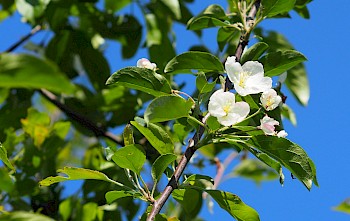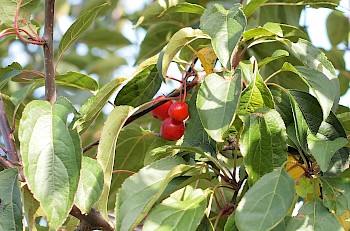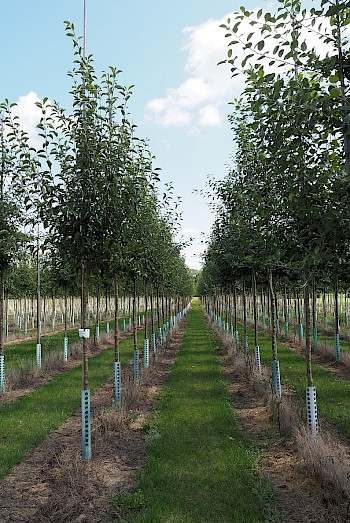6m - 8m
4m - 6m
Half-open
Flower
May
Orange
Wind, Onshore wind
Malus hupehensis ‘Arie Mauritz’ emerged as the best crabapple tree from the cultural value research by PPO Lisse and the Netherlands Inspection Service for Horticulture in 2012. This crabapple combines good growth, health, and good crown layout. Jan P. Mauritz has introduced this CV and named it after his father.
The vigorous growth is noticeable in both the length as well as the trunk width. In its youth, this Malus shows an ascending habit, with a pyramid-shaped, full, and regularly-shaped crown. When maturing, the crown develops into a wider egg-shape. The trunk has coarse bark with lengthwise cracks, which cause chunks to break off. This results in a beautiful patchwork of colours. This species originates from China, where the tree grows up to 12 m in height and width. Here, it stays a little smaller, up to 6-8 m in height.
When the leaves sprout, they are reddish at first, and then turn to a faintly shiny, mid-green colour. The leaves are ovoid, oblong, with a sharply serrated margin. In autumn, the leaves turn orange. The light-pink buds open halfway through May. The large, white flowers have five oval petals. The apples are larger and more numerous than those of other trees of this species. They turn a brilliant, shiny red, hanging from a long stem. The apples will hang far into winter.
Malus hupehensis ‘Arie Mauritz’ is not very demanding when it comes to location. It prefers fertile, humus-rich and permeable soil, not too wet. It can handle pavement, and can therefore be used in public spaces. This selection is also suitable for coastal areas, as it can handle the salty sea breeze without any problems.
Malus hupehensis ‘Arie Mauritz’ does not suffer from scabies, mildew, red lice and aphids, and is very winter hardy.


